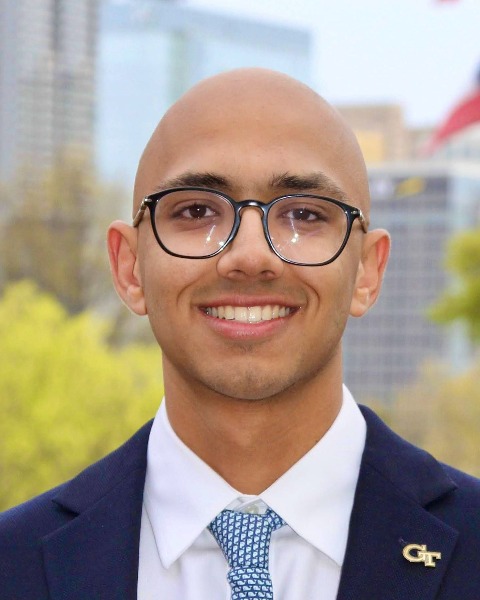Abstract Session
Rapid Fire Research Forum
(AS2) Developing a Machine-learning Algorithm Utilizing Multiparametric Whole-brain-magnetic Resonance Spectroscopy to Predict Glioma Recurrence
Monday, April 24, 2023
2:05pm - 2:10pm PST
Location: Los Angeles Convention Center, 406AB

Shovan Bhatia, BS
Clinical Research Assistant
University of Miami Department of Neurosurgery
Coral Gables, Florida, United States
Presenting Author(s)
Disclosure(s):
Shovan Bhatia, BS: No financial relationships to disclose
Introduction: Recurrence for high-grade gliomas is inevitable despite maximal safe resection and adjuvant chemoradiation. In the molecular era of gliomas, targeted treatment requires informed decision-making that promptly anticipates treatment-failure and disease progression. We have piloted a novel whole-brain magnetic resonance spectroscopy (WB-MRS) protocol to investigate locoregional tumor metabolites and predict tumor recurrence. Here, we present a pilot study investigating the utility of a novel machine-learning algorithm using multiparametric WB-MRS to predict areas and times of recurrence.
Methods: We prospectively conducted postoperative WB-MRS on focal high-grade gliomas with recurrence within 6 months of the initial WB-MRS (n=19; GBM (n=15), Anaplastic Astrocytoma (n=4)). Over 6000 voxels per patient were obtained, and regions of interest (ROIs) were identified: normal-appearing white matter (NAWM), enhancing tumor, and future tumor recurrence. Logistic regression models were trained on five patients and analyzed for six metabolites. Metabolite ratios were evaluated as prognostic factors for predicting recurrence: normalized Choline/Creatine (Cho/Cr), Choline/N-Acetyl-Aspartate (Cho/NAA), and Creatine/N-Acetyl-Aspartate (Cr/NAA). Based on these findings, five machine-learning algorithms (LDA, KNN, SVM, CART, randomForest) were subsequently trained using these ratios with 10-fold cross-validation to predict tumor recurrence.
Results: In our initial testing cohort, median time from WB-MRS to recurrence was 2.26 months (n=5, range: 1.71-4.23). Using enhancing tumor ROIs as positive controls, univariate and multivariate logistic regression indicated that Cho/Cr, Cho/NAA, Cr/NAA ratios were significant amongst six prognostic factors in predicting future recurrence in suspected healthy brain (p < 0.0001). Despite normal imaging on contrast-enhancing-MRI, ROIs of future recurrence had markedly higher Cho/Cr, Cho/NAA, and Cr/NAA ratios compared to NAWM using an ANOVA test (p < 0.0001). KNN achieved the best performance in differentiating regions of tumor from NAWM (accuracy: 0.941; area-under-curve: 0.991).
Conclusion : This pilot study shows the utility of a machine learning-based WB-MRS algorithm in predicting brain tumor recurrence approximately two months in advance and potentially guiding expectant treatment decision-making.
Methods: We prospectively conducted postoperative WB-MRS on focal high-grade gliomas with recurrence within 6 months of the initial WB-MRS (n=19; GBM (n=15), Anaplastic Astrocytoma (n=4)). Over 6000 voxels per patient were obtained, and regions of interest (ROIs) were identified: normal-appearing white matter (NAWM), enhancing tumor, and future tumor recurrence. Logistic regression models were trained on five patients and analyzed for six metabolites. Metabolite ratios were evaluated as prognostic factors for predicting recurrence: normalized Choline/Creatine (Cho/Cr), Choline/N-Acetyl-Aspartate (Cho/NAA), and Creatine/N-Acetyl-Aspartate (Cr/NAA). Based on these findings, five machine-learning algorithms (LDA, KNN, SVM, CART, randomForest) were subsequently trained using these ratios with 10-fold cross-validation to predict tumor recurrence.
Results: In our initial testing cohort, median time from WB-MRS to recurrence was 2.26 months (n=5, range: 1.71-4.23). Using enhancing tumor ROIs as positive controls, univariate and multivariate logistic regression indicated that Cho/Cr, Cho/NAA, Cr/NAA ratios were significant amongst six prognostic factors in predicting future recurrence in suspected healthy brain (p < 0.0001). Despite normal imaging on contrast-enhancing-MRI, ROIs of future recurrence had markedly higher Cho/Cr, Cho/NAA, and Cr/NAA ratios compared to NAWM using an ANOVA test (p < 0.0001). KNN achieved the best performance in differentiating regions of tumor from NAWM (accuracy: 0.941; area-under-curve: 0.991).
Conclusion : This pilot study shows the utility of a machine learning-based WB-MRS algorithm in predicting brain tumor recurrence approximately two months in advance and potentially guiding expectant treatment decision-making.
